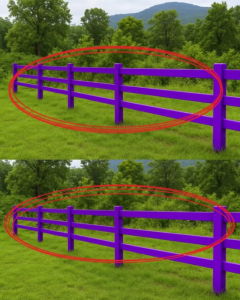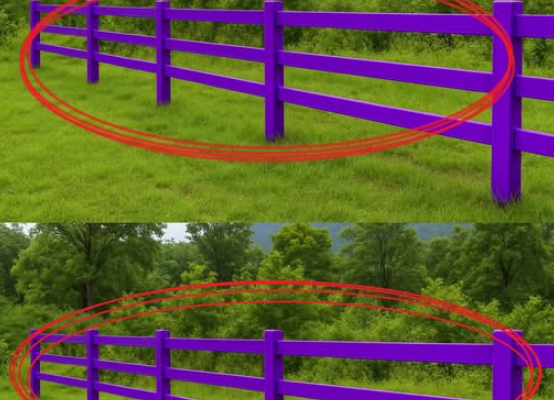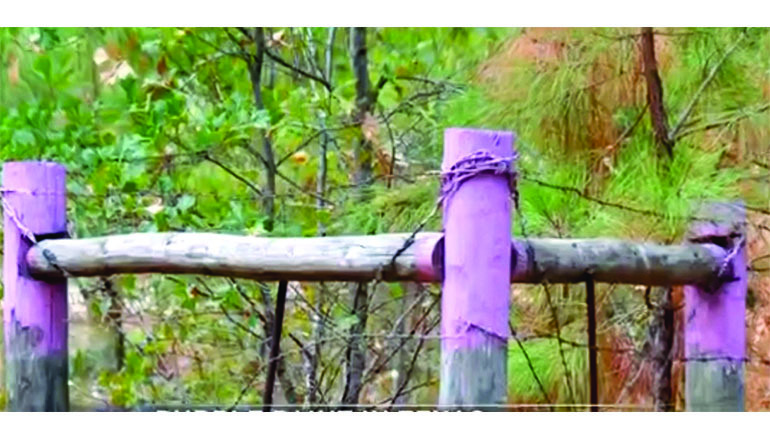
If you’ve ever been driving through the countryside or walking along a rural property and noticed a fence or post painted purple, you might have wondered what it means. Many people think it’s just a decorative choice — after all, purple can be a striking and beautiful color. But in reality, that purple paint is far more than just an aesthetic touch. It’s a legal signal, a clear warning, and a practical alternative to traditional signage. This small detail carries big meaning, especially in certain parts of the United States.
Here’s the deeper story behind the “purple fence law,” why it exists, and what you should do if you ever come across one.
1. What the Purple Fence Actually Means
In several U.S. states, including where the Purple Paint Law is in effect, painting a fence post, tree trunk, or boundary marker purple is a legal way to indicate “No Trespassing.”
Traditionally, property owners would put up metal or wooden “No Trespassing” signs. But these signs can get stolen, vandalized, or worn down over time. Purple paint, on the other hand, is cheap, easy to maintain, and harder to remove. Once applied to fences, posts, or trees, it clearly communicates the same legal message:
👉 “You are not allowed to enter this property without permission.”
In other words, that purple fence is a silent but powerful legal boundary marker.
2. How the Law Works
The purple paint law was first passed in Arkansas in 1989, and over the years, many other states have followed suit, including Texas, Illinois, Kansas, North Carolina, and several more.
Each state may have slightly different regulations, but the general rules are consistent. For the paint markings to be legally valid:
-
Color: The paint must be a specific shade of purple, often described as “purple paint” or “No Trespassing purple.”
-
Placement: Marks must be made on trees or fence posts at regular intervals along the property boundary.
-
Height: Usually between 3 to 5 feet above the ground.
-
Visibility: The paint should be clearly visible to anyone approaching the property.
When these conditions are met, the purple paint carries the same legal weight as a posted sign.
3. Why Purple?
You might be wondering, why not red or yellow? Why purple?
The choice of purple wasn’t random. When lawmakers were debating what color to use, they needed something distinct, uncommon, and easily visible in rural and wooded areas. Purple stood out because:
-
It doesn’t naturally occur on tree bark or fences.
-
It’s bright enough to catch attention but not mistaken for other common markers.
-
It isn’t confused with colors used for hunting trails, utility markings, or emergency signs.
Over time, purple became the standardized color for legal property warnings.
4. Protecting Landowners’ Rights
The purple fence system gives landowners a simple, cost-effective way to assert their rights. For farmers, ranchers, and private property owners, posting physical signs across hundreds of acres can be expensive and time-consuming. Paint, on the other hand, costs only a few dollars a can and lasts for years.
This system is especially important for:
-
Rural landowners: who may have large, unfenced properties.
-
Hunters and hikers: who need clear visual cues about private land boundaries.
-
Law enforcement: who can enforce trespassing laws more effectively when boundaries are clearly marked.
In states with purple paint laws, ignoring these markings is treated the same way as ignoring a posted “No Trespassing” sign — and can lead to fines or even criminal charges.
5. What to Do If You See a Purple Fence
If you’re out for a walk, hike, or drive and notice a fence, gate, or tree painted purple, here’s what you should do:
-
Stop and respect the boundary. Do not enter.
-
Look for other signs. There may also be traditional warning signs, but the paint alone is enough.
-
Turn around or find a public route. Never assume it’s okay to cross just because you don’t see a fence.
-
Understand the law. In many states, entering a purple-marked area without permission is legally trespassing.
Even if you think no one will see you, it’s not worth the risk. These laws exist to protect private property, crops, livestock, and personal safety.
6. What Happens If Someone Ignores the Warning
Trespassing onto land marked with purple paint is just as serious as walking past a “No Trespassing” sign. Depending on the state, penalties can include:
-
Fines: Some states impose hundreds of dollars in fines.
-
Criminal charges: In certain cases, repeat trespassers can face misdemeanor or even felony charges.
-
Civil liability: Landowners can take legal action if damage occurs.
In states with purple paint laws, claiming “I didn’t see a sign” is not a valid defense — the purple paint is the sign.
7. Beyond Fences: Other Uses of Purple Paint
While fences and posts are the most common places for these markings, some landowners also paint:
-
Tree trunks at property lines.
-
Barn doors or outbuildings near the edge of their land.
-
Gates or driveways where people might try to enter.
As long as the paint is applied correctly and visibly, it legally communicates the no-trespassing message.
8. How to Properly Mark Your Property
For those who own property and want to use the purple paint method, here’s a quick guide:
-
Check your state’s specific regulations. Not all states allow purple paint markings yet.
-
Buy the correct paint. Look for “No Trespassing Purple” or “purple boundary paint” at hardware stores.
-
Mark at intervals. Typically every 25 to 100 feet, depending on local laws.
-
Maintain visibility. Repaint every few years if the color fades.
-
Document your markings. Taking photos or keeping a map can help in legal situations.
This simple step can save a lot of trouble later, especially in rural or wooded areas where signage can get lost or damaged.
9. States That Use the Purple Paint Law
While this list can change over time, as of recent years, states that have adopted some version of the purple paint law include:
-
Texas
-
Illinois
-
Kansas
-
Missouri
-
North Carolina
-
Florida
-
Pennsylvania
-
Indiana
-
Arkansas
Some other states are considering similar laws. It’s always smart to check the latest regulations if you’re traveling, hunting, or hiking.
10. Final Thoughts: A Simple Mark with a Strong Message
The next time you see a purple fence, don’t shrug it off as someone’s paint experiment or quirky style. That color has a clear purpose: to protect private land and make boundaries unmistakable.
For property owners, it’s a practical and affordable solution. For visitors, hikers, or hunters, it’s a warning not to cross without permission.
In rural America, a simple streak of purple paint can carry the full weight of the law. Respecting that mark isn’t just courteous — it’s required.




